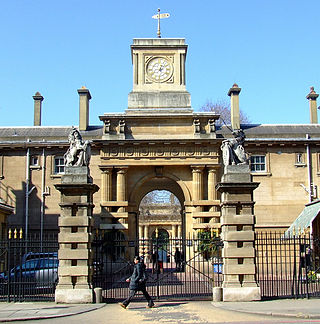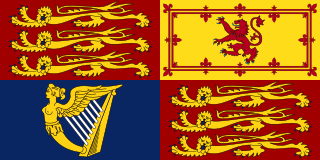
Buckingham Palace is a royal residence in London, and the administrative headquarters of the monarch of the United Kingdom. Located in the City of Westminster, the palace is often at the centre of state occasions and royal hospitality. It has been a focal point for the British people at times of national rejoicing and mourning.

The Governor of New South Wales is the representative of the monarch, King Charles III, in the state of New South Wales. In an analogous way to the Governor-General of Australia at the national level, the Governors of the Australian States perform constitutional and ceremonial functions at the state level. The governor is appointed by the monarch on the advice of the Premier of New South Wales, and serves in office for an unfixed period of time—known as serving At His Majesty's pleasure—though five years is the general standard of office term. The current governor is retired judge Margaret Beazley, who succeeded David Hurley on 2 May 2019.

In military organizations, a colour guard is a detachment of soldiers assigned to the protection of regimental colours and the national flag. This duty is highly prestigious, and the military colour is generally carried by a young officer (ensign), while experienced non-commissioned officers are assigned to the protection of the national flag. These non-commissioned officers, accompanied in several countries by warrant officers, can be ceremonially armed with either sabres or rifles to protect the colour. Colour guards are generally dismounted, but there are also mounted colour guard formations as well.

The King's Body Guard of the Yeomen of the Guard is a bodyguard of the British monarch. The oldest British military corps still in existence, it was created by King Henry VII in 1485 after the Battle of Bosworth Field.

The Palace of Whitehall – also spelled White Hall – at Westminster was the main residence of the English monarchs from 1530 until 1698, when most of its structures, with the notable exception of Inigo Jones's Banqueting House of 1622, were destroyed by fire. Henry VIII moved the royal residence to White Hall after the old royal apartments at the nearby Palace of Westminster were themselves destroyed by fire. Although the Whitehall palace has not survived, the area where it was located is still called Whitehall and has remained a centre of the British government.

A state visit is a formal visit by the head of a sovereign country to another sovereign country, at the invitation of the head of state of that foreign country, with the latter also acting as the official host for the duration of the state visit. Speaking for the host, it is generally called a state reception. State visits are considered to be the highest expression of friendly bilateral relations between two sovereign states, and are in general characterised by an emphasis on official public ceremonies.

Trooping the Colour is a ceremonial event performed every year on Horse Guards Parade in London, United Kingdom, by regiments of Household Division, to celebrate the official birthday of the British sovereign. It is also known as the Sovereign's Birthday Parade. Similar events are held in other countries of the Commonwealth. In the UK, it is, with the State Opening of Parliament, the biggest event of the ceremonial calendar, and watched by millions on TV and on the streets of London.

The Royal Mews is a mews, or collection of equestrian stables, of the British royal family. In London these stables and stable-hands' quarters have occupied two main sites in turn, being located at first on the north side of Charing Cross, and then within the grounds of Buckingham Palace.
The Household Cavalry (HCAV) is a corps of the Household Division that is made up of the two most senior regiments of the British Army – The Life Guards and The Blues and Royals. They have taken part in every major conflict since 1660. These regiments are divided between the Household Cavalry Regiment stationed at Wing Barracks in Wiltshire, with an armored reconnaissance role, and the ceremonial mounted unit, the Household Cavalry Mounted Regiment, garrisoned at Hyde Park Barracks in London. Both the HCMR and HCR are made up of elements of the Life Guards and the Blues and Royals. The Household Cavalry is part of the Household Division and is the King's official bodyguard. Although the Household Cavalry Regiment is armoured, it is not part of the Royal Armoured Corps, being assigned to the Household Division.

Guard mounting, changing the guard, or the changing of the guard, is a formal ceremony in which sentries performing ceremonial guard duties at important institutions are relieved by a new batch of sentries. The ceremonies are often elaborate and precisely choreographed. They originated with peacetime and battlefield military drills introduced to enhance unit cohesion and effectiveness in the late 17th and early 18th centuries.

The King's Colour Squadron, formerly the Queen's Colour Squadron, is the unit of the Royal Air Force charged with the safe-keeping of the King's Colour for the Royal Air Force in the United Kingdom. Since its formation, it has been formed exclusively by Officers and Gunners of No. 63 Squadron RAF Regiment.

Australia's Federation Guard (AFG) is a tri-service ceremonial unit made up of members from the Royal Australian Navy, Australian Army, and Royal Australian Air Force. Formed in 2000 for the centenary celebrations of Federation of Australia, it is the first purely ceremonial unit in the history of the Australian armed forces, and has since represented Australia in various roles both at home and around the world, including providing the Queen's Guard at Buckingham Palace in 2000.Since its inception AFG has supported many notable events; The Royal Edinburgh Military Tattoos held in Australia 2005, 2010 and 2019. The ANZAC commemorations in Western Europe 2014 to 2018. The Queen Elizabeth II Silver and Platinum Jubilee's in the UK. The Queen Elizabeth II's Funeral in the UK 2022. The King Charles III Coronation in the UK 2023.

The King's Guard are sentry postings at Buckingham Palace and St James's Palace, organised by the British Army's Household Division. The Household Division also mounts sentry postings at Horse Guards, known as the King's Life Guard.
An office created in the Private Secretary's Office of the Royal Household of the Sovereign of the United Kingdom in 2004 after a Daily Mirror reporter used a false CV to obtain a job at Buckingham Palace. A subsequent government report recommended the establishment of the Director of Security Liaison role. The first office-holder was Brigadier Jeffrey Cook, a former Special Air Service (SAS) officer. He served until 2008. John Lynes CVO, another military officer, was the Director from around 2015 to 2023.

Public duties are performed by military personnel, and usually have a ceremonial or historic significance rather than an overtly operational role.
Lords-in-waiting (male) or baronesses-in-waiting (female) are peers who hold office in the Royal Household of the sovereign of the United Kingdom. In the official Court Circular they are styled "Lord in Waiting" or "Baroness in Waiting".

Flags at Buckingham Palace vary according to the movements of court and tradition. The King's Flag Sergeant is responsible for all flags flown from the palace.
The Royal Households of the United Kingdom are the collective departments that support members of the British royal family. Many members of the royal family who undertake public duties have separate households. They vary considerably in size, from the large household that supports the sovereign to the household of the Prince and Princess of Wales, with fewer members.

The Yeomen Warders of His Majesty's Royal Palace and Fortress the Tower of London, and Members of the Sovereign's Body Guard of the Yeoman Guard Extraordinary, popularly known as the Beefeaters, are ceremonial guardians of the Tower of London. In principle they are the palace guard, responsible for looking after any prisoners in the Tower, and safeguarding the British crown jewels. They have also conducted guided tours of the Tower since the Victorian era.

State and official visits to the United Kingdom are formal visits by the head of state of one country to the United Kingdom, during which the British Sovereign acts as official host of the visitor. It is a royal event that involves all the assets in the Civil Service, the Royal Household and the Household Division. It also involves other members of the Royal family and is centred in London, the national capital. Invitations for state visits are sent by the Royal Household with supervision by the Foreign and Commonwealth Office.














